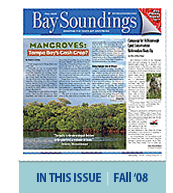 |
||||||||

 The Future of Mangrove Forests and Associated Wetlands
The Future of Mangrove Forests and Associated Wetlands
on Tampa Bay
We used to think that all we had to do was purchase and place in public ownership and management all the mangrove forests on Tampa Bay, and we were home free. All those ecological services like fish and crab production, food for wading birds, and water cleansing powers preserved forever! Unfortunately, it is not so easy.
Over the last four decades, I have spent countless hours in our Florida mangrove wetlands, and in similar areas in 15 foreign countries. I have read the scientific papers as they were generated, and purchased and read the ever more numerous and expensive books on coastal wetlands ecology and management. Based on my experience and reading, and in spite of the rosy predictions of a 166% increase in mangrove forests on Tampa Bay over the next 100 years¹, I have great concern for the future of our coastal wetlands, and those of other estuaries of Florida and the world.
You will note I do not just refer to “mangrove forests.” One of the things we have learned is that wetlands are linked ecosystems -— linked by hydrology. We have a new term for this mix of science: Ecohydrology. What happens in our rivers and streams that flow to Tampa Bay and through our complex mixture of freshwater wetlands, tidal marshes, mangrove forests, tidal flats and seagrass meadows either keeps them healthy or dooms them to an early death. It is the same with the reverse as tide waters flow from the bay upstream. It is very complex, and I will only touch on the high points.
First we have learned that left to their own devices, these wetlands are self maintaining, and even with natural fluctuations in rainfall and rising sea level, they can regulate and adapt to remarkably major changes. Organic soil deposits left by mangroves and marshes around the world tell us that within certain parameters, coastal wetlands, can actually raise themselves up as sea level rises, for example. Thus they can remain in place for hundreds if not thousands of years. But, if we muck things up, they sink. One of the key factors for marshes and mangroves is an adequate supply of both freshwater and sediments. More so these days scientists are reporting on the important role of reduced salinities in the health of marshes and mangroves. Sediments we knew about, though not the positive role of tropical storms. The Mississippi River Delta is collapsing and its associated tidal marshes and a few mangroves are disappearing at alarming rates due to loss of the natural protection and nourishment of freshwater flows and associated sediment loads.
So what does that have to do with the historical delta at the mouth of the Alafia River and other areas of sediment deposition? It means that we need to be carefully managing freshwater flows and insuring that natural tidal stream pathways are maintained or restored, and adequate freshwater flows through these systems. Yes, certainly a hard choice in times of reduced research funding and demand for more water for human use.
One recent paper I reviewed reported on the similarity of fish and invertebrate populations within natural tidal streams and man-made mosquito control ditches. All well and good. However, I hastened to point out in my review that mosquito control ditches are destined over time to fill in and close and produce hydrologic problems for mangroves and marshes. It is happening today, and more instances of declining fish and invertebrate use and ultimately dead mangroves and marshes will be seen on the Bay if we do not act today.
I recently circulated an e-mail suggesting a meeting and discussion on this issue. I got no replies. So I will try again: The Tampa Bay Estuary Program, Florida Department of Environmental Protection and Agency on Bay Management should hold a joint meeting to begin our essential discussion about ecohydrology and the future of our coastal wetlands before it is too late to take action. I am ready to talk about it. Are you?
— Longtime bay advocate Robin Lewis is President of Lewis Environmental Services and the Coastal Resources Group.
¹An Unfavorable Tide. Global Warming, Coastal Habitats and Sportfishing in Florida. National Wildlife Federation. June 2006. 56 pages.
